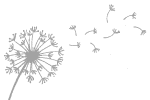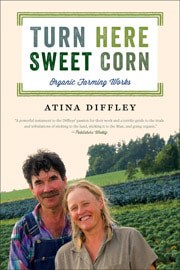Turn Here Sweet Corn Dialog On Urban Planning
I am very happy to write that my recently published memoir, Turn Here Sweet Corn: Organic Farming Works, is stimulating dialogue —as I had hoped! I am receiving wonderful emails from readers with discussion and comments about land use planning. Please keep them coming. A Star Tribune article, Hey, soil sister: Atina Diffley, by reporter Kim Palmer, generated this letter to the editor from Mary Devine. Thank you to Mary.
LOADED LANGUAGE: Developers can’t build unless landowners sell
While I appreciate those who are passionate about organically grown food and enjoyed reading the profile of Atina Diffley (“Soil sister,” April 18), I think it does a disservice to those who build our homes when a reporter writes that “bulldozers are the villians” and that the Diffleys “lost” their farm to suburban development as bulldozers “strafed the land.”
Bulldozers don’t just come over the horizon and take people’s farms. Somebody has to willingly sell their land to a developer. Then that developer (provided the property is zoned for housing) builds the homes we live in.
I don’t know the particulars of this family’s decision, but I do know that no developer, no city, no bulldozer made them sell.
MARY ALICE DIVINE, WHITE BEAR LAKE
Here’s my reply to the editor. I’d love to hear your comments on urban planning or other Turn Here Sweet Corn thoughts.
GOALS FOR FUTURE URBAN PLANNING: LAND PRESERVATION AND LOCAL FOOD PRODUCTION
I appreciate Mary Divine’s April 25th letter to the editor, “LOADED LANGUAGE: Developers can’t build unless landowners sell.” I agree: the developers were not true “villains,” the people responsible for specified harm or damage. Nor were family members who made the difficult decision to sell. They did what society and city planners asked of them. Unfortunately, the benefits the land provided to the community—fresh local food and ecosystem services—were “lost,” and bulldozers most definitely “strafed the land.” They removed the life: the trees, bushes, flowers, and grass. They even removed and sold off the living topsoil—classic 1980s development.
The city of Eagan had left no land zoned for agriculture. Was the Diffley family land “willingly” sold? With the zoning and future of Eagan being what it was and with the system of sewer and water assessment liens, development was a force in motion. It would have required tremendous community effort to reverse it and an understanding of urban edge land use that was not yet widely accepted.
One goal of my memoir, Turn Here Sweet Corn, is to learn from this experience and create a healthier future. For food security and stability, it is crucial that future planning includes land preservation and local food production. Now, during this development downturn, is our perfect opportunity to rethink urban design.
Atina Diffley, author Turn Here Sweet Corn: Organic Farming Works

Read Atina Diffley's Blog: What Is A Farm?
Subscribe By Email. It’s Free
Enter your email address:
Worshops & Consulting
Visit Organic Farming Works LLC for Workshops and Coaching/Consulting with Atina and Martin Diffley.


